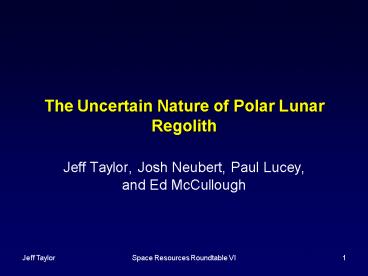The Uncertain Nature of Polar Lunar Regolith PowerPoint PPT Presentation
1 / 17
Title: The Uncertain Nature of Polar Lunar Regolith
1
The Uncertain Nature of Polar Lunar Regolith
- Jeff Taylor, Josh Neubert, Paul Lucey, and Ed
McCullough
2
A Tale of Two Moons
- Perhaps the Moon should be divided into two major
parts - dry (almost all of it)
- icy (permanently-shadowed areas in polar regions)
- Potential differences in
- Regolith grain size distribution
- Agglutinate physical properties, which might
affect bulk regolith properties - Effect of ice and other compounds if present
- We have no direct measurements of any of these
featureswe need them
3
Regolith Grain Size
- In non-polar regions
- Regolith is fine-grained
- Roughly
- 10 smaller than 10 ?m
- 20 smaller than 20 ?m
- Predictable physical properties (porosity,
thermal conductivity, shear and bearing strength,
angle of repose, tribology)
Carrier et al. (1991)
4
Regolith Grain Size
Hartmann (2003) Early heavy bombardment may have
produced deep megaregolith as fine-grained as
surface regolith is today.
5
Regolith Grain Size
- Could regolith in polar regions be much finer
grained as a result of this early bombardment,
with subsequent regolith development atop this
fine-grained deposit? - Finer grained deposit would affect permeability,
but would create larger surface area - In this case the effect may apply to much of the
highlands
6
Agglutinate Properties Normal Dry Moon
Photos courtesy of Larry Taylor
7
Agglutinate Properties Icy Moon
Agglutinates formed in icy regolith might be
extremely frothy, like this sample of reticulite
(basaltic pumice in which cell walls of
bubbles have burstleaves a honeycomb-like
structure.
8
Agglutinate Properties Icy Moon
- Extremely porous agglutinates might lead to
change in physical properties of bulk regolith - Agglutinates make up at least half the volume of
a mature regolith - Would be substantially weaker to both compressive
and tensional forces - Might fragment easily, leading to finer-grained
regolith - Might provide greater grain-to-grain friction
- Could provide places for H2O to precipitate
9
Potential Sources of Polar Hydrogen
- Solar wind hydrogen (indirectly deposited)
- H2O (and possibly CH4 and CO) released from
non-polar soil grains that contain solar wind
gases - Impact of hydrous meteorites
- Impact of comets
- Key point We do not know which of these is most
important
10
Polar Temperatures
Noon
- Models suggest temperatures substantially less
than 100 K in permanently-shadowed regions - Model at right (Vasavada, unpublished) is for a
flat-floored crater like Amudsen
Midnight
11
H2O Deposition as Amorphous Ice
- Numerous H2O structures
- At low lt 100 K and P lt 2 x 108 Pa, precipitates
as amorphous solid
12
Comet Gases
- We do not have solid data on composition of polar
volatile deposits - A good guess is that they contain gases from
comets. For example, in Hale Bopp - H2O 100 CO2 6
- CO 20 NH3 0.7
- CH3OH 2 CH4 0.6
- These could result in deposits of H2O and other
gases - If source is non-polar regolith, there still be
CO and CH4
13
Amorphous Ice Structure Allows Trapping of
Cometary Gases
High-density amorphous ice
Low-density amorphous ice
Jenniskens et al. (1995)
14
Gas Release from Amorphous Ice
- Amount of trapped gas depends on T
- Can be up to 3.3 times the amount of ice at 20 K
(Laufer et al., 1987) - Trapped Ch4/ice and CO/ice are 0.01 at 70 K
- Gas begins to be released at 120 K and increases
exponentially as T approaches 135 K - Transformation to crystalline ice is exothermic,
so there could be a runaway effect, resulting in
losses
15
Clathrate Hydrates
- Duxbury et al. (2001) propose that compounds like
CH46H2O and CO2 6H2O could form at depths of a
few mm to a few meters - Source of gases could be solar wind interactions
in non-polar regions or comets - Their presence might lead to large changes in the
physical properties of the regolith - On Earth, their presence is a concern for
undersea drilling operations because they may
create unstable slopes
16
Other Possible Processes
- Crystallization of amorphous ice and
micrometeorite bombardment add heat to regolith,
which could result in - Loss of H2O
- Formation of frothy agglutinates
- Formation of organic compounds
- Formation of hydrated silicates
- Impact into ice-bearing regolith could produce a
distinctive morphology surrounding craters a few
meters (up to 20 m?) in diameter
17
Conclusions
- Permanently-shadowed regions might be drastically
different from the well-characterized and
reasonably well understood non-polar regions - Laboratory experiments can help shed light on the
possibilities and what types of measurements are
needed - It is essential to study permanently-shadowed
regions in great detail to understand - Nature of hydrogen deposit
- Form of solid water if present
- Stratigraphy of deposits
- Volatility of the regolith, including rate of
loss during heating and handling - Regolith physical properties
- Surface morphology

